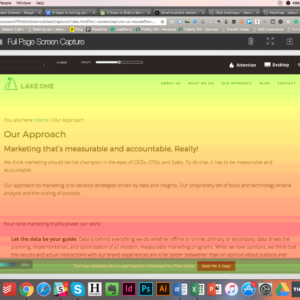When I think back to entering design school, I vividly remember being terrified by the idea of people critiquing my work. What do you mean my teachers and classmates are going to pore over my work at every opportunity and point out every little thing I did wrong? THAT’S what’s going to make me a better designer? It was a tough pill to swallow at first, but I quickly learned just how impactful tough love could be on my development, both in terms of advancing my skills and levelling out my ego. In fact, research shows that most people actually want to hear negative feedback more regularly so they can continue to improve.
But it’s not that simple. Negative feedback should be constructive. There are ways to soften the blows and foster collaboration to ensure a successful project. If you find yourself in the position to give design feedback, consider these tips:
Be super specific
“I want this to pop!”
“Just make it look nice.”
“I don’t like (insert design elements here).”
I think I speak for all designers when I say that I loathe hearing any of the above statements from a client. It has nothing to do with the negative or suggestive nature of the comments, it’s the fact that they aren’t specific about what the problem is. In order to get the best end result, you have to be willing to explain your thoughts in a clear and concise way. Instead of providing a non-specific “I don’t like this” comment, try your best to put words behind exactly what it is you don’t like (and don’t worry about using proper design terminology). Whether it’s the colour, font, or just the overall vibe of the design, getting specific with your likes and dislikes will send the designer back to the drawing table with options and actionable feedback.

Make it impersonal
While constant critiques have left most designers with pretty thick skin, it’s best to remember that feelings can still be hurt depending on the delivery of the feedback. To avoid making waves, most of us default to the sandwich method of giving feedback, in which you sandwich negative or critical comments in between positive ones. The issue with this approach is that sometimes the pain points can get lost or overlooked in favour of the positive ones.
To avoid this, try giving feedback in a passive voice so as not to critique anyone personally. Keep it about the work (not the designer) by asking questions like “Why was it designed this way?” as opposed to “Why did you design it this way?”. Tapping into the thought behind a decision will give you better insight into the designer’s approach and potentially pinpoint ways their skills could be better used to fulfill your vision. You’ll also avoid playing the blame game and maybe save some tears along the way, too.

Ask all the questions
When working with a designer, sometimes the best thing to do is get their side of the story. Ask for the reasoning behind a design decision you aren’t a fan of before you jump the gun and nix something based only on your gut feeling. Design is meant to be collaborative, so critiques are the perfect time for everyone to get their thoughts out on the table in order to reach the best solution together.
At the same time, don’t forget to ask questions about things you like as well. Designers put a lot of thought and research into their work and want to flex their design thinking skills. Ask about their choices to give them the opportunity to show you you’re in good hands. Doing this can build connections and make the process more fun by fostering the feeling of collaboration and teamwork. You’re all in it together.

Keep the brief in mind
Before providing feedback from a purely visual standpoint, refer back to the goals of the project to see how they’re being met. Creative that misses the mark could be a result of the designer interpreting the goals of the project differently than intended. While everyone tries their best to outline the specific needs of a project during the discovery period, things can get missed or glossed over. That’s why it’s best to communicate what you’d like the design to accomplish throughout the project—not just at the beginning. By doing this, you’ll likely reduce the amount of back-and-forth and revisions needed to reach the finish line.
There’s never going to be a perfect way to deliver negative feedback. Thick skin can only be so thick and non-designers can only throw words like “sans-serif” and “drop shadow” around incorrectly so many times. But if you consider how you’re fostering collaboration, asking questions, and approaching feedback as a whole, you’re well on your way to being a master critiquer.
Your designer and the end product will thank you for it.
Business & Finance Articles on Business 2 Community
(49)







